Birdfinding.info ⇒ The Sumba endemic form of Yellow-crested Cockatoo—increasingly recognized as a separate species—is critically endangered due to a combination of habitat loss and illegal capture for the international pet trade. Sites where it has traditionally been found include Manupeu Tanadaru National Park on the southwestern side of the island and Laiwangi Wanggameti National Park in the southeast.
“Citron-crested Cockatoo”
Cacatua sulphurea citrinocristata
Endemic to Sumba Island in the Lesser Sundas of Indonesia, where it persists mostly in remnant forest fragments.
Trapping for the illegal cagebird trade caused the population to decline rapidly in recent decades, from an estimated 3,200 in 1992 to around 560 in 2012. However, localized increases have been noted in some areas as well.
Identification
A mid-sized white cockatoo with an apricot-orange crest. Traditionally regarded as a distinctive subspecies of Yellow-crested Cockatoo—but starting in 2021, some authorities, including BirdLife International, recognize it as a separate species. The one clear distinction is the crest coloration: orange versus yellow. Otherwise, in all key measurements (bill, wing, tail, crest), “Citron-crested” apparently falls within the range of the various Yellow-crested populations that inhabit other islands of the region. (For a detailed comparison of the several similar forms in this complex, see Identification of Yellow-crested Cockatoos.)
The frontal feathers of the crest are white, and the middle and hind-crown feathers are pale-orange, long, and up-curved—so their tips point forward when the crest is raised. At rest, the white shield partly obscures the orange feathers.
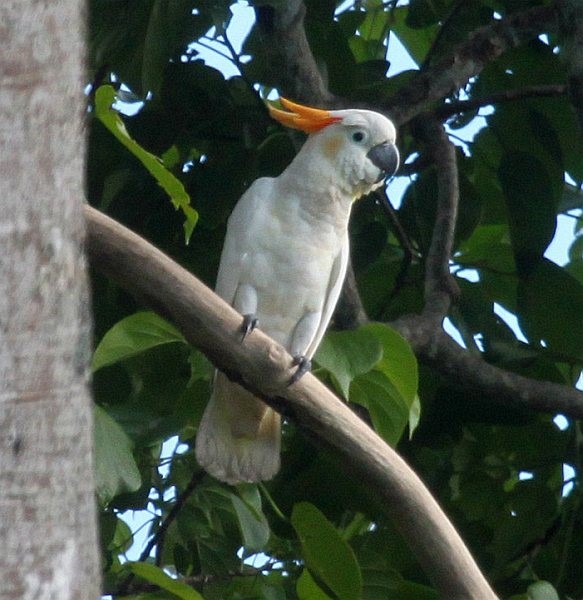
“Citron-crested Cockatoo”, C. s. citrinocristata. (Manurara, Manupeu Tanadaru National Park, Sumba, Indonesia; January 26, 2013.) © Hanom Bashari
“Citron-crested” usually shows an orangish patch on the cheeks or ear-coverts—where typical Yellow-crested usually have a yellowish patch. Some individuals also show a smudgy orangish collar

“Citron-crested Cockatoo”, C. s. citrinocristata, with crest fanned out. (Sumba, Indonesia; July 2018.) © Yovie Jehabut
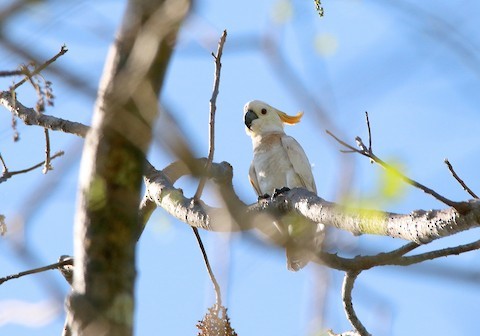
“Citron-crested Cockatoo”, C. s. citrinocristata. (Sumba, Indonesia.) © Tim Avery
As in other white cockatoos, the undersides of the wings and tail are suffused with a yellowish wash—although on “Citron-crested” the tone often appears more orange or brownish.

“Citron-crested Cockatoo”, C. s. citrinocristata. (Sumba, Indonesia.) © Pitta Tours
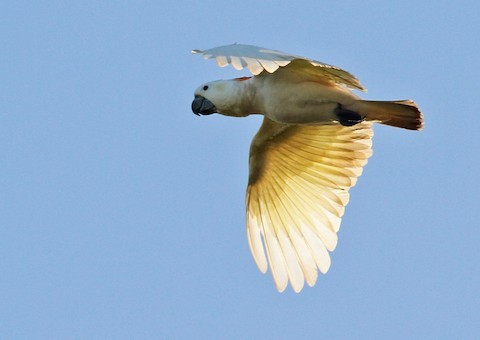
“Citron-crested Cockatoo”, C. s. citrinocristata. (Sumba, Indonesia; July 28, 2010.) © Lars Petersson
Voice. Typical calls are mellow screeches (apparently less harsh than most typical Yellow-crested subspecies): Watumabela, Bilur Pangadu, Sumba, Indonesia; July 25, 2012. © Pamela C. Rasmussen
Notes
Monotypic form, one of two distinct forms of Yellow-crested Cockatoo (sulphurea). The Handbook of the Birds of the World and BirdLife International recognized citrinocristata and sulphurea as separate species in 2021. This reclassification may be correct, and clearly advances a conservation purpose, but taxonomically it seems to be a borderline call.
IUCN Red List Status: Critically Endangered.
See below for a comparison of the “Citron-crested Cockatoo” with the nominate form of Yellow-crested Cockatoo. (For comparison with other similar forms, see Identification of Yellow-crested Cockatoos.)
Cf. Yellow-crested Cockatoo. “Citron-crested” and typical Yellow-crested Cockatoos are closely related forms that inhabit adjacent islands in the Lesser Sundas. They are approximately the same size and overall coloration, with the only consistent difference being the coloration of the crest: yellow versus pale apricot-orange.
They do not occur together naturally, but because both are popular cagebirds both can occur anywhere (climate permitting). There are no known introduced populations of “Citron-crested”, but one or more individuals may have appeared around Singapore (though these individuals could possibly be hybrids of Yellow-crested with another species such as Salmon-crested—see Additional Photos below).
According to the initial study of populations traditionally classified as Yellow-crested, “Citron-crested” has comparatively long wings, tail, and crest feathers. However, an isolated Yellow-crested subspecies, abbotti, exceeds it in all of these measurements. “Citron-crested” appears to have a larger, deeper-based bill than most Yellow-crested, but a different subspecies, sulphurea, has a similar-sized bill. Based on publicly available recordings, it appears that “Citron-crested” may have a deeper, mellower voice.
Additional Photos of “Citron-crested Cockatoo”
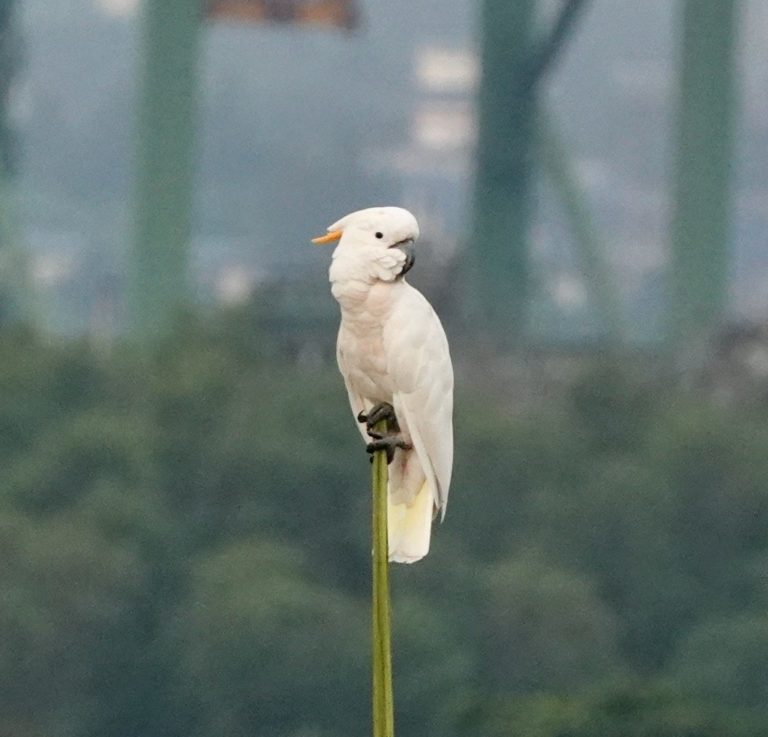
An apparent feral “Citron-crested Cockatoo”, C. s. citrinocristata—or possibly a hybrid of Yellow-crested and Salmon-crested Cockatoos. (Singapore; September 2020.) © Marcel Finlay

Either a feral “Citron-crested Cockatoo”, C. s. citrinocristata, or a hybrid of Yellow-crested and Salmon-crested Cockatoos—with Tanimbar Corella in background. (Singapore; November 8, 2020.) © Marcel Finlay
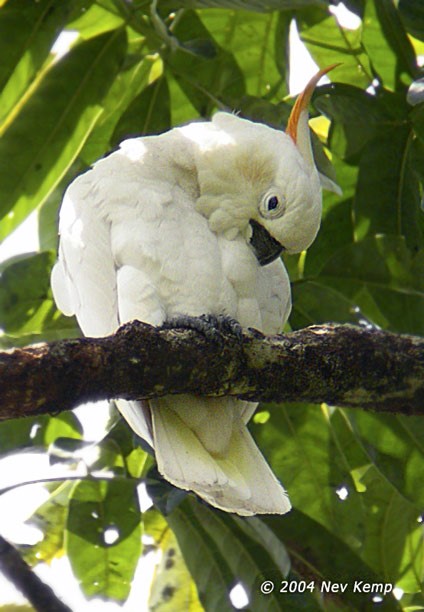
“Citron-crested Cockatoo”, C. s. citrinocristata. (Sumba, Indonesia; September 18, 2004.) © Neville Kemp

“Citron-crested Cockatoo”, C. s. citrinocristata. (Sumba, Indonesia.) © Mick Greene
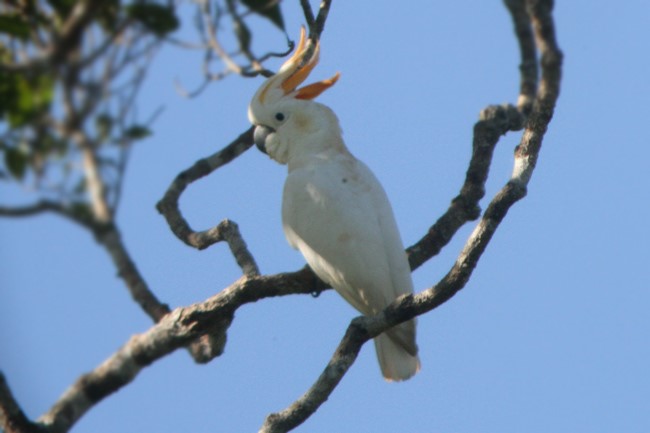
“Citron-crested Cockatoo”, C. s. citrinocristata. (Sumba, Indonesia; July 2010.) © James Eaton
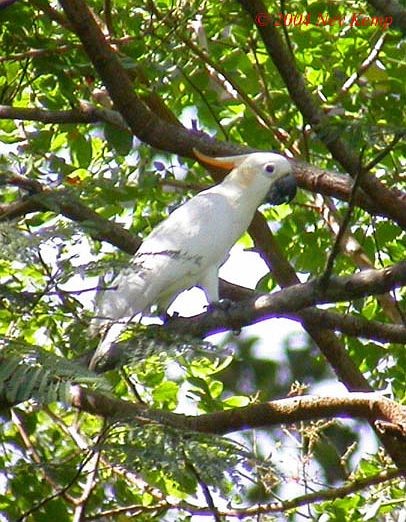
“Citron-crested Cockatoo”, C. s. citrinocristata. (Sumba, Indonesia; April 11, 2004.) © Neville Kemp

“Citron-crested Cockatoo”, C. s. citrinocristata. (Maradesa, Sumba, Indonesia; January 28, 2013.) © Hanom Bashari
References
BirdLife International. 2018. Cacatua sulphurea. The IUCN Red List of Threatened Species 2018: e.T22684777A131874695. https://dx.doi.org/10.2305/IUCN.UK.2018-2.RLTS.T22684777A131874695.en. (Accessed August 10, 2021.)
BirdLife International. 2021. BirdLife’s Globally Threatened Bird Forums: Citron-crested Cockatoo (Cacatua citrinocristata): Revise global status? https://globally-threatened-bird-forums.birdlife.org/citron-crested-cockatoo-cacatua-citrinocristata-revise-global-status/. (Posted June 2, 2021. Accessed August 10, 2021.)
Cameron, M. 2007. Cockatoos. CSIRO Publishing, Collingwood, Victoria, Australia.
Collar, N.J., and S.J. Marsden. 2014. The subspecies of Yellow-crested Cockatoo Cacatua sulphurea. Forktail 30:23-27.
eBird. 2021. eBird: An online database of bird distribution and abundance. Cornell Lab of Ornithology, Ithaca, N.Y. http://www.ebird.org. (Accessed August 10, 2021.)
Forshaw, J.M. 2010. Parrots of the World. Princeton University Press.
Juniper, T., and M. Parr. 1998. Parrots: A Guide to Parrots of the World. Yale University Press.
Michigan State University. 2021. AVoCet: Avian Vocalizations Center. https://avocet.integrativebiology.natsci.msu.edu/. (Accessed August 10, 2021.)
Mulawki, E.J. 2014. The Cockatoos: A Complete Guide to the 21 Species. McFarland Publishing, Jefferson, N.C.
